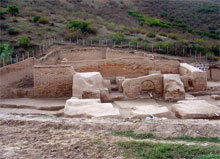Experts believe the Gorgan Great Wall in northern Iran's Golestan Province was built at about the same time as the 'Great Wall' and was used as a defence system against the invasions of the Ephthalites, a nomadic people who once lived in Central Asia.

|
| ©Unknown |
| A view of Gorgan's Defensive Wall. |
Archaeologists also discovered a 50-kilometre long stretch of a canal near the wall that was used to transfer water from the Gorganrud River to the people who once lived in the vicinity of the wall.
According to Hamid Omrani, the leader of the Iranian team, this section of the canal was still in use until the 1979 Islamic Revolution when French engineers built the Voshmgir Dam.
Mehr News Agency reported that last week, the team, which includes experts from the universities of Durham and Edinburgh, also discovered a sixteenth century fort at the Gorgan Great Wall.



Reader Comments
to our Newsletter